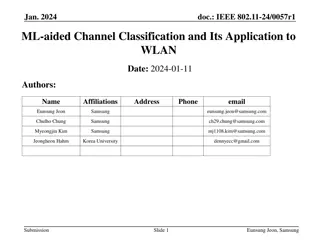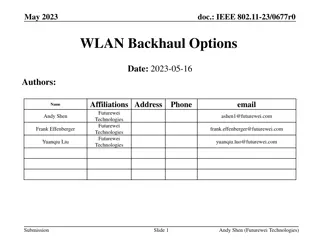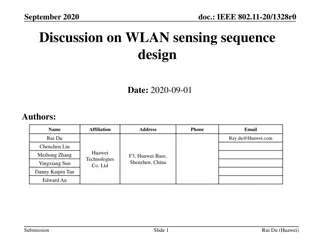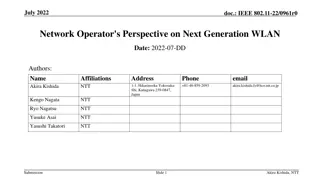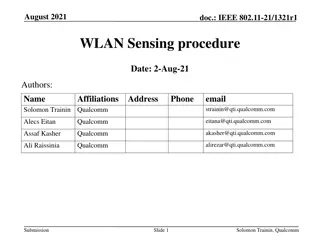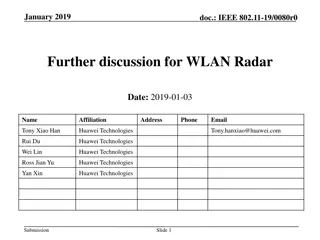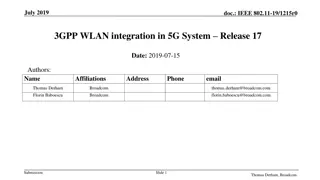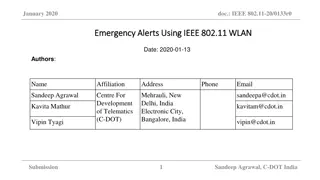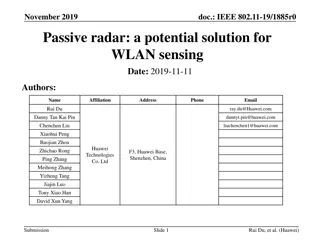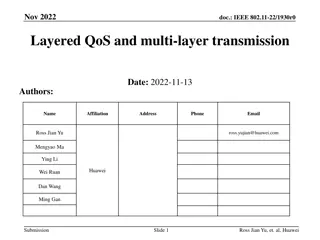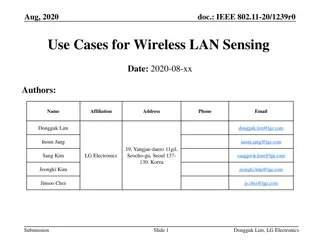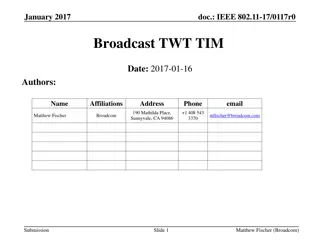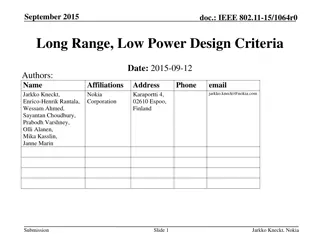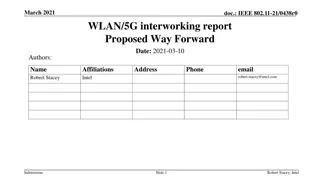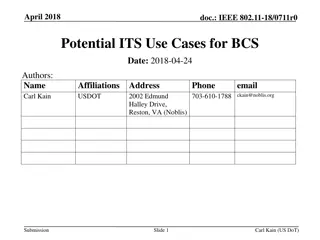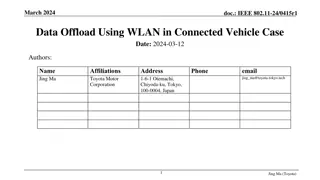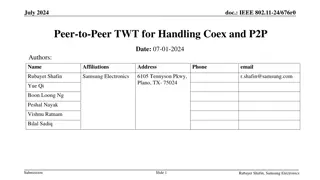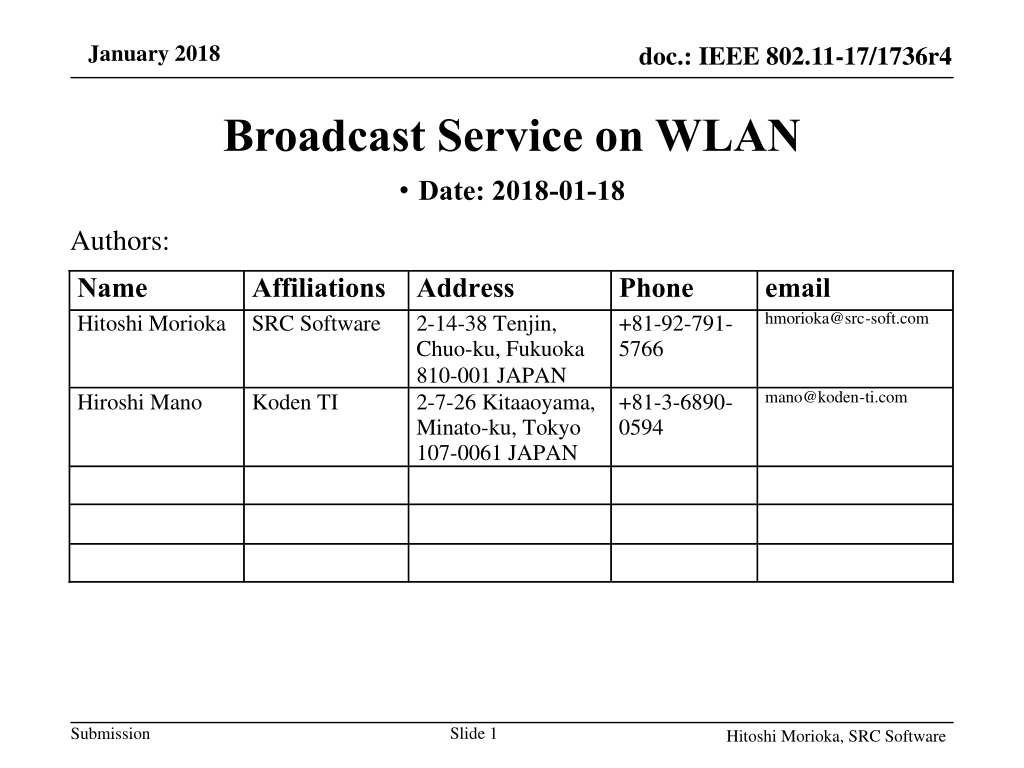
Enhancing User Experience with WLAN Broadcast Service
This presentation proposes a broadcast service on WLAN to improve user experience by providing local information efficiently. It discusses the motivation behind utilizing WLAN for broadcasting and presents use cases such as live streaming and displaying less frequently changed information. The potential benefits of using WLAN for local broadcasting are highlighted, emphasizing its ability to enhance user engagement and reduce bandwidth consumption.
Download Presentation

Please find below an Image/Link to download the presentation.
The content on the website is provided AS IS for your information and personal use only. It may not be sold, licensed, or shared on other websites without obtaining consent from the author. If you encounter any issues during the download, it is possible that the publisher has removed the file from their server.
You are allowed to download the files provided on this website for personal or commercial use, subject to the condition that they are used lawfully. All files are the property of their respective owners.
The content on the website is provided AS IS for your information and personal use only. It may not be sold, licensed, or shared on other websites without obtaining consent from the author.
E N D
Presentation Transcript
January 2018 doc.: IEEE 802.11-17/1736r4 Broadcast Service on WLAN Date: 2018-01-18 Authors: Name Hitoshi Morioka SRC Software Affiliations Address Phone +81-92-791- 5766 email hmorioka@src-soft.com 2-14-38 Tenjin, Chuo-ku, Fukuoka 810-001 JAPAN 2-7-26 Kitaaoyama, Minato-ku, Tokyo 107-0061 JAPAN mano@koden-ti.com Hiroshi Mano Koden TI +81-3-6890- 0594 Slide 1 Submission Hitoshi Morioka, SRC Software
January 2018 doc.: IEEE 802.11-17/1736r4 Abstract This presentation describes a proposal of broadcast service on WLAN. Slide 2 Submission Hitoshi Morioka, SRC Software
doc.: IEEE 802.11-17/1736r4 January 2018 Motivation Currently broadcast on WLAN is mainly used for communication management protocols, such as Beacon and Probe for IEEE802.11 ARP, DHCP and NDP for higher layer Broadcasting contents will enhance user experience. Many people need common information at specific locations, such as Live comments at a stadium, Explanation at a tourist attraction, Timetable at a train station, Floor plan at a shopping mall, or Emergency information. We call them local information in this presentation. Currently people need to do the following actions to get local information. Search web site. Get the local information by unicast traffic. These actions waste channel time/bandwidth. Broadcasting local information on WLAN can reduce per user bandwidth. Slide 3 Submission Hitoshi Morioka, SRC Software
doc.: IEEE 802.11-17/1736r4 January 2018 Broadcast Service on WLAN WLAN is a suitable medium for local broadcasting service, but it is not used. Radio wave is suitable for broadcasting based on its nature. Anyone in the range can receive. Frequently changed information, such as vacant space at a parking lot, can be reflected in real time. IEEE802.11 WLAN has broadcast mechanism (group address) Unlicensed Locality Low cost Slide 4 Submission Hitoshi Morioka, SRC Software
doc.: IEEE 802.11-17/1736r4 January 2018 Use Case 1 (Live Streaming) AP Train STA Anyone in stadium, museum or zoo who has a smartphone can listen audio guidance/comments without additional hardware. Multiple logical channels can be used. Multilingual broadcasting can be supported on a single radio channel. Of course, any type of data can be broadcast, such as video, text, HTML Hitoshi Morioka, SRC Software Slide 5 Submission
doc.: IEEE 802.11-17/1736r4 January 2018 Use Case 2 (Less Frequently Changed Information) AP Train STA Smartphone Digital Signage Device Anyone in a shopping mall, conference venue like here, who has a smartphone can see the floor guide on their device. Anyone in a train station who has a smartphone can see the timetable on their device. Digital signage device in the area can show the same information. Hitoshi Morioka, SRC Software Slide 6 Submission
doc.: IEEE 802.11-17/1736r4 January 2018 Use Case 3 (Emergency Information) Broadcasting infrastructure can be used for distributing emergency information such as: Evacuation guidance in case of fire. Earthquake warning. Food information in a evacuation shelter. Hitoshi Morioka, SRC Software Slide 7 Submission
doc.: IEEE 802.11-17/1736r4 January 2018 Use Case 4 (Sensor Data Collection) Sensors can broadcast their data. Assume to collect sensor data periodically. If association is not required, sensors transmit just data frames periodically. This means periodical data collection by broadcast may reduce sensor power consumption. In this case, a sensor works as AP (broadcast station). Data Collector Sensor (as AP) Data Collector Sensor Sensor Sensor Periodical Data Association Data Collector Data Data Sensor Sensor By existing standard By broadcast Hitoshi Morioka, SRC Software Slide 8 Submission
doc.: IEEE 802.11-17/1736r4 January 2018 What to Consider Security Transmitters have to be authenticated by receivers. Encryption should be optionally supported. Session Establishment Simplify the session establishment. QoS For broadcast frames. For other frames. Application Selector Identify the type of contents (text, audio, video...) to select application. Hitoshi Morioka, SRC Software Slide 9 Submission
doc.: IEEE 802.11-17/1736r4 January 2018 Security Requirements To prevent fake information distribution, the source of information shall be identified. Because of dense deployment in the assumed use cases, the fake AP causes a disruption of the services. Every broadcast frame shall be authenticated by the receivers. Encryption may be optional. Most broadcasting contents are considered as public and preferred to be widely distributed. But private broadcast service should be supported. Hitoshi Morioka, SRC Software Slide 10 Submission
doc.: IEEE 802.11-17/1736r4 January 2018 Current Broadcast Security on WLAN Required to join GTKSA. GTK and Key RSC are shared by EAPOL-key or, in case of 802.11ai, Key Delivery element in Association Response. Current GTKSA uses AES, a kind of Symmetric-key algorithm . An AP and non-AP STAs in a GTKSA shares the same GTK and Key RSC/TSC. The AP encrypts broadcast frames by using the GTK and the Key TSC. The non-AP STA decrypts broadcast frames by using the GTK and the Key RSC. This means Any STAs which can decrypt broadcast frames can produce encrypted broadcast frames . So a malicious user can produce fake broadcast frames. The receivers can NOT check the integrity of broadcast frames. Encrypt (GTK, TSC) AP AP Mac address spoofing malicious STA STA STA STA Decrypt (GTK, RSC) Decrypt (GTK, RSC) Decrypt (GTK, RSC) STA STA Encrypt (GTK, RSC) Decrypt (GTK, RSC) Decrypt (GTK, RSC) Hitoshi Morioka, SRC Software Slide 11 Submission
doc.: IEEE 802.11-17/1736r4 January 2018 Issue on the Current GTKSA If all STAs in the GTKSA are trusted, the current GTKSA works well. Trust means that all STAs don t have malicious intent. In case of public WLAN, like assumed use case, malicious users can join. Security enhancement is required even if using current security mechanism (.11i, .11ai). Hitoshi Morioka, SRC Software Slide 12 Submission
doc.: IEEE 802.11-17/1736r4 January 2018 Public Key Based Frame Authentication AP STA To prevent fake AP issue, use public key. Public key algorithms are high cost. It may be combined with shared key algorithm. Every frame shall have an authenticator to provide per frame authentication. Public Key Data + Authenticator Data + Authenticator Data + Authenticator Data + Authenticator Data + Authenticator AP STA Establish GTKSA encrypt(Public Key) Limit the receivers by the existing GTKSA mechanism Encrypt the key and data by GTK. Or, create new mechanism. encrypt(Data + Authenticator) encrypt(Data + Authenticator) encrypt(Data + Authenticator) encrypt(Data + Authenticator) encrypt(Data + Authenticator) Hitoshi Morioka, SRC Software Slide 13 Submission
doc.: IEEE 802.11-17/1736r4 January 2018 Session Establishment AP STA In case of not using encryption, the required security can be provided without existing Authentication/Association. Other negotiations in existing Association are not required in broadcast services. All parameters are decided only by the AP. This may cause state machine modification and new broadcast data frame definition. Public Key Data + Authenticator Data + Authenticator Data + Authenticator Data + Authenticator Data + Authenticator AP STA Establish GTKSA or have pre-shared key In case of using encryption, existing Authentication/Association can be used for establishing GTKSA. If the AP and the STAs have pre-shared key, existing Authentication/Association may be omitted even in case of using encryption. encrypt(Public Key) encrypt(Data + Authenticator) encrypt(Data + Authenticator) encrypt(Data + Authenticator) encrypt(Data + Authenticator) encrypt(Data + Authenticator) Hitoshi Morioka, SRC Software Slide 14 Submission
doc.: IEEE 802.11-17/1736r4 January 2018 QoS Considerations Contents broadcasting may use much bandwidth. QoS for both broadcast frames and unicast frames should be considered. QoS for broadcast frames In general, the loss rate of broadcast frame is higher than unicast frame. Broadcast does not have ACK mechanism. Existing 802.11 uses BCC/LDPC. Is required stronger FEC/Interleaving algorithm? Consider to apply 802.11aa GCR mechanism. In this case, association to AP is required. QoS for other .11 frames How much bandwidth can be used for broadcasting? Define limit of bandwidth? Adaptive control? Consider to apply 802.11aa OBSS management. Hitoshi Morioka, SRC Software Slide 15 Submission
doc.: IEEE 802.11-17/1736r4 Higher Layer Support In November session, we proposed that the application layer locates just above the IEEE802.11 layer. Broadcast service on WLAN is used only between an AP and STAs. Routing is not required. IP is not required. Broadcast service on WLAN is one- way service from an AP to STAs. Flow control, such as TCP is not required. To simplify the protocol, application layer will locate just above the IEEE802.11 layer. IEEE802.11 should define application selector such as RTP, MIME. IEEE802.11 header Application selector Application data Expected frame format January 2018 Hitoshi Morioka, SRC Software Slide 16
doc.: IEEE 802.11-17/1736r4 January 2018 Issues on This Layer Design This model seems to make layer violation. IP and UDP layer should be used. How does the AP identify the frames to be broadcasted? The frames to be broadcasted should be identified by their destination MAC address. Frame Server AP Broadcast or not? Hitoshi Morioka, SRC Software Slide 17 Submission
doc.: IEEE 802.11-17/1736r4 January 2018 Solution To use IP layer, IP address has to be assigned to every STA. IPv4 has no standards to assign IP address without frame transmission by STA. IPv6 can assign IP address without frame transmission by STA. By using Router Advertisement Duplicate Address Detection is not required. (STA never transmit frames) Mapping IPv6 multicast address to MAC address is defined in RFC2464. AP can select frames to be broadcasted by the specified MAC address ( = IPv6 multicast address) Hitoshi Morioka, SRC Software Slide 18 Submission
doc.: IEEE 802.11-17/1736r4 January 2018 Updated Layer Design IEEE802.11 header IEEE802.11 header Application selector IPv6 header UDP header Application data Application data (e.g. RTP) IETF standards can be used to identify application data type. Hitoshi Morioka, SRC Software Slide 19 Submission
doc.: IEEE 802.11-17/1736r4 January 2018 Conclusion Broadcast service on WLAN can improve user experience. For broadcast service on WLAN, the following works are required. Make frame authentication mechanism Modify state machine Define broadcast data frame Consider QoS Application selector Hitoshi Morioka, SRC Software Slide 20 Submission
doc.: IEEE 802.11-17/1736r4 January 2018 Comments & Questions Hitoshi Morioka, SRC Software Slide 21 Submission
doc.: IEEE 802.11-17/1736r4 January 2018 Straw poll Do you support to form study group for broadcast service on WLAN ? Yes: 31 No: 3 Don t care: 13 Need more info: 23 Hitoshi Morioka, SRC Software Slide 22 Submission



